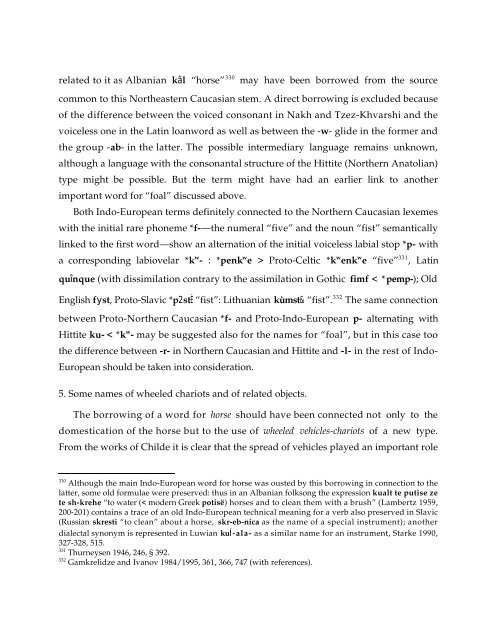Comparative Notes on Hurro-Urartian, Northern Caucasian
Comparative Notes on Hurro-Urartian, Northern Caucasian
Comparative Notes on Hurro-Urartian, Northern Caucasian
Create successful ePaper yourself
Turn your PDF publications into a flip-book with our unique Google optimized e-Paper software.
elated to it as Albanian kâl “horse” 330 may have been borrowed from the source<br />
comm<strong>on</strong> to this Northeastern <strong>Caucasian</strong> stem. A direct borrowing is excluded because<br />
of the difference between the voiced c<strong>on</strong>s<strong>on</strong>ant in Nakh and Tzez-Khvarshi and the<br />
voiceless <strong>on</strong>e in the Latin loanword as well as between the -w- glide in the former and<br />
the group -ab- in the latter. The possible intermediary language remains unknown,<br />
although a language with the c<strong>on</strong>s<strong>on</strong>antal structure of the Hittite (<strong>Northern</strong> Anatolian)<br />
type might be possible. But the term might have had an earlier link to another<br />
important word for “foal” discussed above.<br />
Both Indo-European terms definitely c<strong>on</strong>nected to the <strong>Northern</strong> <strong>Caucasian</strong> lexemes<br />
with the initial rare ph<strong>on</strong>eme *f-—the numeral “five” and the noun “fist” semantically<br />
linked to the first word—show an alternati<strong>on</strong> of the initial voiceless labial stop *p- with<br />
a corresp<strong>on</strong>ding labiovelar *k w - : *penk w e > Proto-Celtic *k w enk w e “five” 331 , Latin<br />
quînque (with dissimilati<strong>on</strong> c<strong>on</strong>trary to the assimilati<strong>on</strong> in Gothic fimf < *pemp-); Old<br />
English f^yst, Proto-Slavic *p2stÈ “fist”: Lithuanian kùmst& “fist”. 332 The same c<strong>on</strong>necti<strong>on</strong><br />
between Proto-<strong>Northern</strong> <strong>Caucasian</strong> *f- and Proto-Indo-European p- alternating with<br />
Hittite ku- < *k w - may be suggested also for the names for “foal”, but in this case too<br />
the difference between -r- in <strong>Northern</strong> <strong>Caucasian</strong> and Hittite and -l- in the rest of Indo-<br />
European should be taken into c<strong>on</strong>siderati<strong>on</strong>.<br />
5. Some names of wheeled chariots and of related objects.<br />
The borrowing of a word for horse should have been c<strong>on</strong>nected not <strong>on</strong>ly to the<br />
domesticati<strong>on</strong> of the horse but to the use of wheeled vehicles-chariots of a new type.<br />
From the works of Childe it is clear that the spread of vehicles played an important role<br />
330 Although the main Indo-European word for horse was ousted by this borrowing in c<strong>on</strong>necti<strong>on</strong> to the<br />
latter, some old formulae were preserved: thus in an Albanian folks<strong>on</strong>g the expressi<strong>on</strong> kualt te putise ze<br />
te sh-krehe “to water (< modern Greek potisë) horses and to clean them with a brush” (Lambertz 1959,<br />
200-201) c<strong>on</strong>tains a trace of an old Indo-European technical meaning for a verb also preserved in Slavic<br />
(Russian skresti “to clean” about a horse, skr-eb-nica as the name of a special instrument); another<br />
dialectal syn<strong>on</strong>ym is represented in Luwian kuÍ-ala- as a similar name for an instrument, Starke 1990,<br />
327-328, 515.<br />
331 Thurneysen 1946, 246, § 392.<br />
332 Gamkrelidze and Ivanov 1984/1995, 361, 366, 747 (with references).





